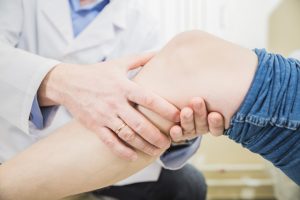What is the difference between Chondropathy and Osteoarthritis?
First of all the cartilage layer on the bone ends of the joints, plays an essential role in the mobility of the joints. This cartilage ensures that both joint halves can slide smoothly over each other. It also ensures that shocks and impacts are absorbed. When too much force is exerted on the cartilage, abnormalities of this flexible tissue may occur. It may turn into osteoarthritis, but that is not always the case. In osteoarthritis there is a uniform wear of the cartilage over the entire surface. Eventually the cartilage disappears completely, causing the underlying bone to be exposed. In other situations small damages can befall the cartilage, such as rough spots and pits. This uneven wear is then referred to as chondropathy. This condition can occur in all joints, but the knee is especially sensitive to it. In the knee this is referred to as retropatellar chondropathy.
What is chondropathy?
“Chondropathy is actually the pre-stage of osteoarthritis. The cartilage is damaged and will therefore also become thinner and thinner. And then we just talk about Osteoarthritis, “
explains orthopedic surgeon Jan Ide de Jong.
A cartilage disorder is divided into four grades in medical science. Chondropathy is measured in grades 1 through 3. First, the cartilage surface softens and the resilient properties decrease. Then small cracks develop in the cartilage and the surface becomes rough. At grade 3 the cracks and grooves extend further than half the thickness of the cartilage. Chondropathy is then called pre-osteoarthritis. In the last stage, chondropathy has completely changed to osteoarthritis. The cartilage is then almost completely gone and the two bone ends are exposed. In the case of retropatellar chondropathy, the layer of cartilage deteriorates at the back of the kneecap.
What is retropatellar chondropathy?
The name of this condition is a composition of the words ‘behind the kneecap’ (retropatellar) and ‘cartilage injury’ (chondropathy). Imbalance of the muscles located at the front of the upper leg usually cause this form of chondropathy. As a result, stretching the knee pulls the kneecap out of place. The kneecap does not move properly in the groove of the upper leg. This ‘bad track’ gives an increased pressure on the back of the kneecap. As a result, damage can occur to the cartilage present there.
What causes retropatellar chondropathy?
The damage to the cartilage in retropatellar chondropathy develops very gradually. The most important cause is a long and wrong overload of the knee joint. As a result, the muscle balance changes and the kneecap no longer follows the track of the joint surface of the upper leg. But injury to the kneecap, and prolonged immobilisation – for example, leg in plaster – can also trigger this cartilage disease. This condition is more common in women than men. Athletic women between 18 and 30 years and women with bow legs are in the danger zone for developing retropatellar chondropathy.
What are the symptoms of retropatellar chondropathy?
The main symptom is pain at the front of the knee, especially around the kneecap. Bending the knee usually causes pain to develop. For example climbing, cycling, squatting, and even sitting for a long time, may cause pain. That is why retropatellar chondropathy is also called a ‘theater knee’. In time, the knee can also start to ache at rest. The knee may have swollen due to fluid accumulations (edema).
How do you treat retropatellar chondropathy?
The doctor can make the diagnosis if the patient indicates that there is pain around the kneecap when stretching the knee against resistance. An examination of the kneecap mobility is also done. Swelling and reduction in the size of the thigh muscle only occur in the later stages. In many cases, retropatellar symptoms are not severe. The goal of the treatment is to remove the cause, in hopes it will not develop into osteoarthritis. The doctor will ask you to give the knee a rest and possibly send you to a physiotherapist. He will teach you how to relieve the knee and do exercises with you to strengthen the muscles around the knee. Surgery is not usually an option, because to date, the results are disappointing. Moreover, an operation is stressful for the joint.
Five tips to save your knees
• Try to avoid deep knee bends as much as possible. So be careful with climbing, jumping, climbing stairs, etc.
• Are you overweight? Weight loss will reduce the pressure on your knees.
• Cycle in the lightest possible resistance to exert less force with your knees.
• For the swimmers: breaststroke is stressful for the knees. Therefore choose the freestyle or back crawl.
• Always wear good footwear when you are running.

Share this page
Tweet

Download for free the booklet ‘Moving without pain’ with a retail value of $6.75 / £4.95.
Any questions? Please feel free to contact us. Contact us






